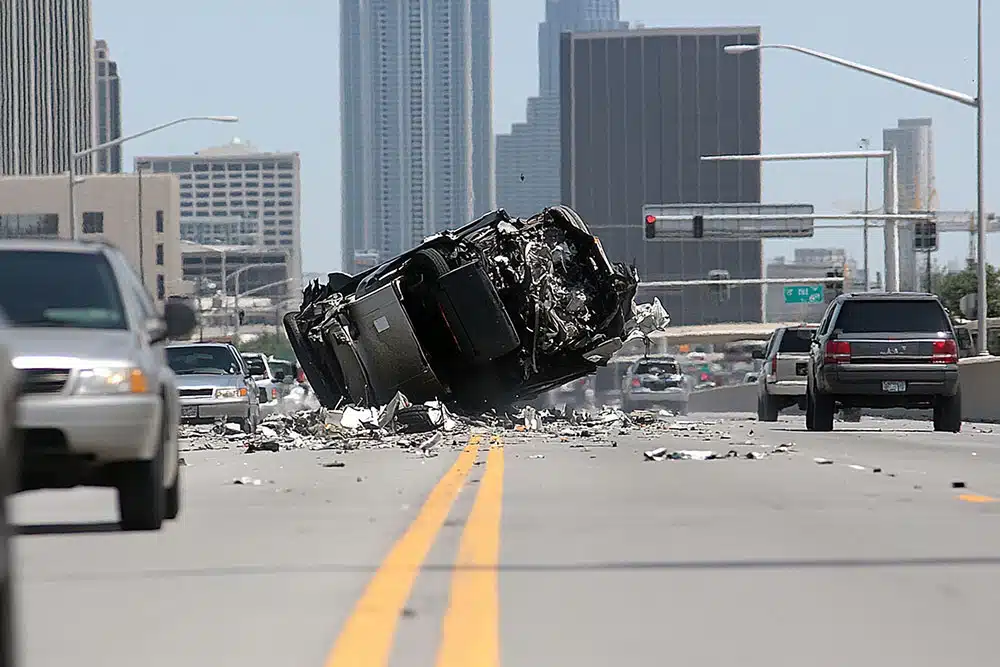
Riding a bike is a great way to get around, but cars and trucks can make cycling dangerous. Bike accidents happen for many reasons, but inattentive or reckless drivers are often the cause.
When a cyclist gets hit by a vehicle, they are badly hurt because they don’t have the same protection as someone inside a car.
If you or someone you know was injured in a bicycle accident, talk to a bicycle accident lawyer who knows these cases well. They help you understand what to do next and work on getting you compensation to pay for your medical bills and other costs.
The lawyer will investigate how the accident happened, gather evidence, and talk to the insurance company for the person who caused the crash.
If the insurance company doesn’t offer enough money, your lawyer can sue them to get what you deserve.
Here’s what you should know about the most common types of bicycle accidents:
Types of Bicycle Accidents
Bicycle accidents occur in various ways, each presenting unique challenges for cyclists:
Bicycle accidents happen due to various factors, but motorists’ negligence often plays a significant role:
- Right hook: Drivers turning right must check blind spots and yield to straight-traveling cyclists. Cutting off cyclists is dangerous and illegal.
- Left cross: Left-turning motorists must yield right-of-way to oncoming cyclists. Drivers should look carefully and judge cyclists’ speed accurately to avoid collisions.
- Dooring: Parked car occupants check for cyclists before opening doors. Dooring accidents are preventable if drivers and passengers are vigilant.
- Rear-end collisions: Distracted or tailgating drivers put cyclists at risk. Motorists must maintain a safe following distance and pay attention to the road to avoid hitting cyclists from behind.
- Road hazards: While cyclists should report hazards, municipalities are responsible for timely maintenance. Drivers should also watch for potholes and debris to avoid swerving into cyclists.
- Sideswipe: Motorists passing cyclists must provide a safe distance, as law requires. Drivers should be patient, wait for clear opportunities, and never compromise cyclists’ safety.
- Right-of-way violations: Drivers must respect cyclists’ right-of-way at intersections, stop signs, and crosswalks. Yielding is not optional; it’s a legal obligation.
Cyclists have the same rights and responsibilities as other road users. While proactive cycling habits are essential, motorists must drive cautiously and responsibly around bicycles.
If a driver’s negligence causes an accident, injured cyclists should consult a bicycle accident attorney to protect their rights, hold the driver accountable, and seek fair compensation for damages.
Common Bicycle Accident Injuries
When cyclists get hurt in accidents, the injuries can be terrible and change their lives forever. People who ride bikes must know about these injuries and how they can happen to help prevent them.
Some common injuries are:
- Head injuries: Even when wearing a helmet, cyclists can get concussions, skull fractures, and brain damage. These injuries can cause problems with thinking, feeling, and moving for a long time.
- Broken bones: Cyclists often break bones in their arms, legs, wrists, and collarbones during accidents. Broken bones need a lot of medical care and time to heal.
- Road rash: When cyclists slide on the road, they can get nasty scrapes, cuts, and skin loss. Road rash can become infected and leave scars if not appropriately handled.
- Muscle and ligament damage: A crash can stretch, tear, or crush muscles, ligaments, and tendons. This can cause long-lasting pain, make it hard to move, and require extensive therapy.
- Spine injuries: Damage to the spine can cause paralysis, making it hard or impossible for cyclists to move and feel parts of their body.
- Internal injuries: Hard hits can cause bleeding, organ damage, and other dangerous problems inside the body that might not be seen right away.
- Mouth and face injuries: Cyclists may break teeth and jaw bones and get face cuts in a crash. They may need expensive dental work and surgery.
These bad injuries show why it is so important to hold drivers responsible when they cause accidents. Knowing how serious bicycle accidents can be, cyclists must stand up for their rights and get the money they need for medical bills, missed work, pain, and other problems.
Cycling and Distracted Driving
Distracted driving and cycling are a big problem on our roads today. When people pay attention to other things instead of driving, it leads to accidents that hurt or even kill people.
Drivers might look at their phones to read a text or play with an app. When they do, they’re not watching the road. They might not see a cyclist, a red light, or something in the way. This can cause bad crashes that change people’s lives forever.
It’s not just phones and technology that can distract people. Eating, drinking, putting on makeup, or talking to others in the car can also make it harder to focus on driving. Anytime someone stops paying full attention, they endanger themselves and others.
Distracted driving and cycling are hazardous. People have died, been badly hurt, and had their lives changed forever because someone chose to focus on something else instead of being safe on the road.
We all need to work together to stop distracted driving and punish people who don’t pay attention while driving. Too many people are getting hurt, which should no longer be ignored.
Cyclist’s Rights
Like all users of public roads, cyclists have specific rights and responsibilities designed to ensure their safety and smooth roadway sharing with motorists and pedestrians.
Cyclists who understand these rights can navigate the roads confidently and securely. This knowledge also empowers cyclists to advocate for themselves in the unfortunate event of an accident.
Here are the fundamental rights cyclists have on the roads:
Right to Use the Road
Roads are not exclusively for motorized vehicles. Cyclists have the fundamental right to use the road, except where expressly prohibited, such as certain freeways, motorways, or pedestrian-only areas.
Right to Safe Passing by Vehicles
Motorists must maintain a safe passing distance when overtaking cyclists. This distance varies by jurisdiction but is commonly a minimum of three feet.
This rule protects cyclists from being sideswiped or forced off the road by passing vehicles.
Right to Signal and Maneuver
Cyclists follow the same rules for signaling and turning as motor vehicles, emphasizing their equal status on the road. They signal turns and make necessary maneuvers on the road, including turning left or right and changing lanes.
Right to Roadway Positioning
Cyclists have the right to position themselves safely on the road.
This includes “taking the lane” when necessary for safety reasons, such as avoiding obstacles, being visible at intersections, or when the lane is too narrow for a bicycle and a vehicle to travel side by side safely.
While cyclists are often encouraged to use bike lanes where available, they are not obligated to if those lanes are unsafe or impractical for their destination.
Right to Equitable Treatment by Laws
Cyclists have the right to be treated equitably under the law. The legal system affords them the same considerations and protections as motorists.
In the event of accidents, cyclists must receive fair treatment by law enforcement and the judicial system, including access to legal recourse and compensation for damages or injuries.
Right to Safe Infrastructure
While this may vary by jurisdiction, there is a growing recognition of cyclists’ rights to safe and accessible cycling infrastructure.
This includes properly maintained bike lanes, secure bike parking, and road designs that accommodate the safe coexistence of cyclists with other road users.
Advocating for Cyclist Rights
Cyclists can advocate for their rights by being informed, respectful road users, participating in local cycling advocacy groups, and supporting policies and infrastructure projects that promote cycling safety and accessibility.
In cases where rights are infringed upon, seeking legal counsel can ensure justice and legal protection.
Understanding and exercising these rights is not just about individual safety; it’s about fostering a culture of respect and shared use among all road users.
How Can a Bicycle Accident Lawyer Help?
A bicycle accident, you may need to deal with injuries, potential financial strain, and navigating legal complexities.
This is where you need a bicycle accident lawyer’s experience. A lawyer can offer comprehensive support, protecting your rights and recovering the compensation you deserve.
Here’s how a lawyer can assist you after a bicycle accident:
Legal Skill and Guidance
A lawyer with experience in bicycle accidents deeply understands the laws and regulations that pertain to your situation. They can provide clear, informed guidance on your legal rights and options.
This skill is invaluable in navigating the confusing legal landscape surrounding road accidents, including understanding how local traffic laws affect your case.
Evaluating Your Case
One of the first steps a lawyer takes is to evaluate the specifics of your case to determine the best course of action. This includes assessing the extent of your injuries, the damage to your bicycle, and any other losses you have suffered.
With their know-how, a lawyer accurately calculates the compensation you’re entitled to, considering medical expenses, lost wages, pain and suffering, and any long-term care needs.
Investigating the Accident
A thorough investigation builds a solid case. A lawyer can take the lead in gathering evidence, including police reports, witness statements, video footage from surveillance cameras, and expert testimony regarding the accident’s impact on your life.
This comprehensive approach ensures that no stone is left unturned in proving negligence by the other party involved.
Dealing with Insurance Companies
Insurance companies minimize the compensation paid out to claimants every chance they get. Lawyers negotiate with insurance companies for your best interests.
A legal professional protects you from lowball offers and can confidently navigate the insurance claims process. A lawyer’s negotiation skills can obtain a fair settlement that covers your needs.
Representing You in Court
While most bicycle accident claims settle out of court, some cases require litigation. If your case goes to trial, having a lawyer will make or break your case.
They represent you in court, effectively presenting your case and arguing on your behalf. Their experience in trial proceedings ensures that your voice is heard and your case is presented in the best possible light.
Providing Emotional and Professional Support
Beyond legal assistance, a lawyer offers significant emotional and professional support. They understand the stress and anxiety of an accident and can guide you through the process with compassion and empathy.
This support can be invaluable as you navigate the recovery process, allowing you to focus on healing while they handle the legal aspects.
Ensuring Timely Filing
Legal claims are subject to statutes of limitations, which vary by jurisdiction. A lawyer files all necessary documentation and claims within these legal time frames, protecting your right to compensation.
After a bicycle accident, an experienced personal injury lawyer can significantly improve the outcome of your case.
From offering knowledgeable legal advice to negotiating with insurance companies and representing clients in court, a lawyer’s role is crucial in ensuring clients receive the justice and compensation they deserve.
Their experience and knowledge not only level the playing field but also provide you with the peace of mind needed to focus on your recovery.
Call our law office at (800) 624-8888 to help answer all your questions and determine how much compensation you are owed.





